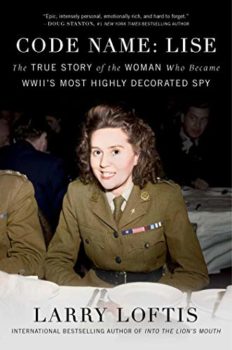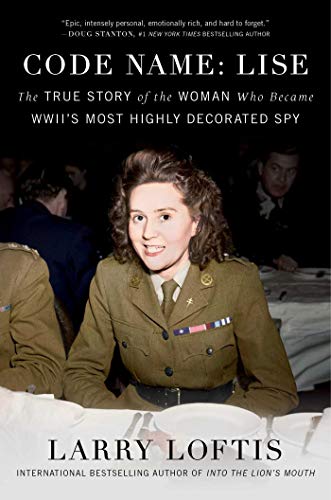
Estimated reading time: 5 minutes
She was the most decorated spy in World War II of either gender. Her name was Odette Sansom (later Odette Hallowes). From 1942 to 1945, she served as an officer of Britain’s Special Operations Executive. From November 1942 to April 1943, she worked in southern France as a courier for an SOE network that delivered arms, money, and supplies to the French Resistance. Betrayed by the witless leader of a French network operating in the same area, she was arrested along with her leader and lover, Captain Peter Churchill.
Odette spent the rest of the war in prison, first in France and later at the notorious Ravensbrück concentration camp for women. And when it was all over, she emerged as the war’s most highly decorated spy. Yet these bare-bones facts convey not a hint of the woman’s almost superhuman courage, the subject of Larry Loftis‘s excellent portrait, Code Name: Lise.
This post was updated on March 24, 2021.
Code Name: Lise: The True Story of the Woman Who Became World War II’s Most Highly Decorated Spy by Larry Loftis (2019) 385 pages ★★★★★
A case of superhuman courage
It’s difficult to grasp how extraordinarily brave Odette Sansom was (or, if you prefer, foolhardy.) For example, traveling with Captain Churchill on a French train, she noted that the Germans included a two-franc-per-person tax on their bill in the dining car. The money was to assist orphans of parents killed during the war. Odette grabbed the check and rushed over to a neighboring table where a German general sat. “Placing the stub before him, she said, ‘I think that you, who are instrumental in bringing about the need for this fund, should pay for this ticket.'” Apparently, the general was so shocked that he simply paid the tax. How could he possibly have imagined that the woman standing before him was supplying the French Resistance with arms and explosives, and that she would become World War II’s most highly decorated spy?
An amazing true tale of chutzpah
Later, when the pair was staying at a hotel with other agents at Christmastime, she discovered that German officers also staying there had commandeered the hotel’s piano and had it moved to their room. Since she and her colleagues wanted to have a party, she “persuaded three German officers to move a piano upstairs so [her network’s] team could enjoy Christmas Eve in proper fashion.” This is what my grandmother called chutzpah.
Masquerading as Winston Churchill’s niece
Later still, after she and Churchill were captured, Odette told her captors two consequential lies. First, she insisted that she, not her boss, Churchill, was the brains of the operation. She described her lover as a “dolt,” which he most assuredly was not. And she claimed that he was a nephew of Prime Minister Winston Churchill and that they were married. These lies prevented the Germans from torturing Churchill and, eventually, allowing him to survive the war. Sansom herself was not so lucky. Gestapo officers removed all ten of her toenails in a futile effort to force her to reveal the location of other members of her network. However, she, too, did survive the war, possibly because the Germans seemed to believe she too was related to the Prime Minister.
She was World War II’s most highly decorated spy (of either gender)
Loftis tells this story in a highly readable style full of dialogue constructed from the extensive records that have survived. Odette Sansom’s experience was by no means typical of the SOE story. But in relating the tale of this one-of-a-kind French-British woman, he makes us understand just what one fiercely determined person can do in the face of almost unimaginable pressure.
For related reading
This is one of the 10 top WWII books about espionage and 10 true-life accounts of anti-Nazi resistance.
Larry Loftis later published a second novel about a female spy. It’sThe Princess Spy: The True Story of World War II Spy Aline Griffith, Countess of Romanones (The American fashion model who spied for the Allies in World War II).
Odette Sansom was also one of the women portrayed in D-Day Girls: The Spies Who Armed the Resistance, Sabotaged the Nazis, and Helped Win World War II by Sarah Rose, which I reviewed at The women who parachuted behind German lines and helped secure the Normandy landing.
Another courageous woman who had an outsized impact on the conduct of World War II is the subject of Madame Fourcade’s Secret War: The Daring Young Woman Who Led France’s Largest Spy Network Against Hitler by Lynne Olson. My review is at The truth about the French Resistance, dug out of old records.
Also, this is one of many good books about Female spies and saboteurs in World War II I’ve reviewed here.
You might also be interested in:
- 10 top nonfiction books about World War II
- The 10 best novels about World War II
- Good books about the French Resistance
- Rogue Heroes: The History of the SAS, Britain’s Secret Special Forces Unit that Sabotaged the Nazis and Changed the Nature of War, by Ben MacIntyre (The story of the original special forces).
And you can always find my most popular reviews, and the most recent ones, on the Home Page.


























